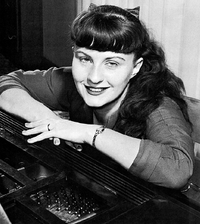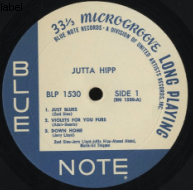Jutta Hipp
| Jutta Hipp | |
|---|---|
 | |
| Background information | |
| Born |
February 4, 1925 Leipzig, Germany |
| Died |
April 7, 2003 (aged 78) New York City, New York, U.S. |
| Genres | Jazz |
| Occupation(s) | Musician, composer |
| Instruments | Piano |
| Years active | 1940s–60 |
Jutta Hipp (February 4, 1925 – April 7, 2003) was a jazz pianist and composer who also had some success as a painter.
Early life
Hipp was born on February 4, 1925 in Leipzig, Germany.[1] Her family was middle class, with a Protestant background.[2] She began playing the piano at the age of nine.[3] She first studied painting in Germany.[1] Jazz was disapproved of by Nazi Germany, so Hipp listened to it during "clandestine gatherings in friends' homes and [...] during bombing raids. Instead of joining her parents and brother in the basement shelter [...] she hunkered down in front of the radio transcribing jazz tunes played on forbidden radio stations."[2] She studied at the East German Leipzig Academy of Graphic Arts before moving as a refugee to West Germany in 1946 after Russia occupied Leipzig.[3][2]
Later life and career
"After the war she became a displaced person and suffered from malnutrition and lacked most basic necessities."[2] She had a son, Lionel, in Germany in 1948,[2] named after Lionel Hampton. He was fathered by an African-American GI.[2] As African-American GIs at that time could not accept paternity to a white woman, the specifics of Lionel's father are unknown.[2] Hipp soon gave him up for adoption.[2]
Hipp worked with saxophonist Hans Koller from 1951, touring in Germany and other countries.[4] They recorded together in 1952.[1] In Germany she also led a quintet between 1953 and 1955;[1] Albert Mangelsdorff's brother Emil was one of the members.[5] In 1954 Hipp played with Attila Zoller. In January of the same year, critic Leonard Feather heard Hipp in Germany, around three years after being sent a recording of her playing by a friend of hers.[3][2] He booked an April recording session for her; the resulting album was released two years later.[2] Later in 1954, Hipp played at the Deutsches Jazzfestival in Frankfurt.[6]
Feather arranged a visa for Hipp, and found her a piano job at the Hickory House club in New York.[3] She moved to the United States in 1955,[3] where she spent most of her life. She played at the Hickory House for six months from March 1956.[3] She played at the Newport Jazz Festival in the same year and recorded for Blue Note Records, again with Feather's help.[3] One of these albums was with saxophonist Zoot Sims.[3][1] This was her final recording.[1]
A story from her time playing in New York clubs is that drummer Art Blakey asked her play with his band one night, but "she refused, saying she was drunk, and anyway did not think she was good enough. Blakey dragged her to the piano, and started playing at a furious tempo which she could not handle. Blakey then addressed the audience: 'Now you see why we don't want these Europeans coming over here and taking our jobs!'"[4]
"Hipp was a rather shy individual who suffered from severe stage fright throughout her career and drowned her fears with excessive alcohol and life-long chain smoking."[2] She may have regarded playing the piano as a way of making money in difficult post-war circumstances rather than as an artistic vocation.[2] As it became more difficult to earn enough money as a jazz musician, Hipp may have decided to take a more stable job.[2] She worked in a clothing factory, continued to play on weekends, but started working for Wallachs clothing company in 1960, where she stayed for 35 years.[2] Some reports stated that she was a seamstress,[3] but a later account indicates that she "prepare[d] frayed or torn men's pants for alterations".[2] Feather may have desired a romantic involvement with Hipp and been rejected, but this is unlikely to have been the reason for the rapid decline of her musical career.[2]
Hipp also returned to her first interest of painting.[1] In 1995, the "German magazine Jazz Podium reproduced her painted caricatures of some jazz musicians; Hipp commented that, "With painting, they look at the work, not you".[4]
Hipp cut herself off from the music industry.[3] She suffered from depression and struggled to maintain relationships.[2] Around 1986, she restarted giving interviews.[2] Until 2000, Blue Note did not know where to send her royalty checks.[3] Lee Konitz was one of a few musicians who kept in touch with her until her death in Queens. Hipp died of pancreatic cancer on April 7, 2003, in her apartment in Sunnyside, Queens.[2] She never married, but was once engaged to Attila Zoller.[2] An obituary writer stated that "Hipp has no known survivors",[3] although her son was still alive and living in Germany in 2013.[2]
Playing style
Hipp's original influence was Lennie Tristano.[1] She was criticized at an early stage for being too similar in style to Horace Silver's blues-based rhythms, having left cool jazz and bebop behind.[1][2] Ben Ratliff, writing in The New York Times, commented that Hipp "developed a style that was lean, percussive, swinging and interrupted with plenty of rests, not far from Horace Silver's style but more low-key."[3] The Penguin Guide to Jazz observed that Hipp is "not as easy to pigeonhole as some accounts suggest. There are extra notes in many of the chords that give them a tense, slightly jangling quality, but Hipp was also capable of playing with delicate lyricism [...] and with a rugged, funky edge".[6]
Legacy
After her death, Hipp became of some interest as a woman instrumentalist in the New York jazz scene.[7]
In 2011, a street in Leipzig was named after Hipp – Jutta-Hipp-Weg.[8]
Discography

As leader/co-leader
| Year recorded | Title | Label | Personnel/Notes |
|---|---|---|---|
| 1952–55 | The German Recordings 1952–1955 | Jazz Haus | Some tracks trio, with Franz "Shorty" Roeder (bass), Karl Sanner (drums); some tracks quartet, with Hans Koller (tenor sax) added; some tracks quintet, with Albert Manglesdorff (trombone) added, Rudi Sehring (drums) replaces Sanner on some; some tracks quintet, with Joki Freund (tenor sax), Atilla Zoller (guitar), Harry Schell (bass), Sanner (drums)[9] |
| 1954 | New Faces – New Sounds from Germany | Blue Note | Some tracks trio, with Hans Kresse (bass), Karl Sanner (drums); some tracks quartet, with Jaki Freund (tenor sax) or Emil Mangelsdorff (alto sax) added; some tracks quintet; released as 10-inch LP[10] |
| 1955* | Cool Europe | MGM | Has two tracks each by Johnny Dankworth, and Albert Hall 1955 |
| 1955 | Jutta Hipp with Lars Gullin | Karusell | Quartet, with Lars Gullin (baritone sax), Simon Brehm (bass), Bosse Stoor (drums); EP |
| 1956 | At the Hickory House Volume 1 | Blue Note | Trio, with Peter Ind (bass), Ed Thigpen (drums); in concert |
| 1956 | At the Hickory House Volume 2 | Blue Note | Trio, with Peter Ind (bass), Ed Thigpen (drums); in concert |
| 1956 | Jutta Hipp with Zoot Sims | Blue Note | Quintet, with Zoot Sims (tenor sax), Jerry Lloyd (trumpet), Ahmed Abdul-Malik (bass), Ed Thigpen (drums) |
References
- ↑ 1.0 1.1 1.2 1.3 1.4 1.5 1.6 1.7 1.8 Yanow, Scott "Artist Biography". AllMusic. Retrieved March 3, 2015.
- ↑ 2.0 2.1 2.2 2.3 2.4 2.5 2.6 2.7 2.8 2.9 2.10 2.11 2.12 2.13 2.14 2.15 2.16 2.17 2.18 2.19 2.20 2.21 Myers, Marc (May 28, 2013) "Jutta Hipp: The Inside Story". JazzWax.
- ↑ 3.0 3.1 3.2 3.3 3.4 3.5 3.6 3.7 3.8 3.9 3.10 3.11 3.12 Ratliff, Ben (April 11, 2003) "Jutta Hipp, 78, Jazz Pianist with a Lean, Percussive Style". The New York Times.
- ↑ 4.0 4.1 4.2 "Jutta Hipp". (April 22, 2003) The Daily Telegraph.
- ↑ "Blue Note Records Discography: 1953–1954". jazzdisco.org. Retrieved March 3, 2015.
- ↑ 6.0 6.1 Cook, Richard and Morton, Brian (2008) The Penguin Guide to Jazz Recordings (9th ed.). Penguin. p. 708. ISBN 978-0-141-03401-0.
- ↑
- ↑ Tamarkin, Jeff (October 27, 2011) "German Street Named After Obscure Blue Note Artist Jutta Hipp". JazzTimes.
- ↑ McClenaghan, Dan (June 2, 2013) "Jutta Hipp: Lost Tapes: The German Recordings 1952–1955 (2013)". AllAboutJazz.
- ↑ Dryden, Ken "Review". AllMusic. Retrieved March 2, 2015.
External links
|